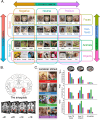Beyond faces: the contribution of the amygdala to visual processing in the macaque brain
- PMID: 38864574
- PMCID: PMC11485272
- DOI: 10.1093/cercor/bhae245
Beyond faces: the contribution of the amygdala to visual processing in the macaque brain
Abstract
The amygdala is present in a diverse range of vertebrate species, such as lizards, rodents, and primates; however, its structure and connectivity differs across species. The increased connections to visual sensory areas in primate species suggests that understanding the visual selectivity of the amygdala in detail is critical to revealing the principles underlying its function in primate cognition. Therefore, we designed a high-resolution, contrast-agent enhanced, event-related fMRI experiment, and scanned 3 adult rhesus macaques, while they viewed 96 naturalistic stimuli. Half of these stimuli were social (defined by the presence of a conspecific), the other half were nonsocial. We also nested manipulations of emotional valence (positive, neutral, and negative) and visual category (faces, nonfaces, animate, and inanimate) within the stimulus set. The results reveal widespread effects of emotional valence, with the amygdala responding more on average to inanimate objects and animals than faces, bodies, or social agents in this experimental context. These findings suggest that the amygdala makes a contribution to primate vision that goes beyond an auxiliary role in face or social perception. Furthermore, the results highlight the importance of stimulus selection and experimental design when probing the function of the amygdala and other visually responsive brain regions.
Keywords: NHP fMRI; amygdala function; emotional valence; social relevance; visual categories.
© Published by Oxford University Press 2024.
Figures






Similar articles
-
Macaque claustrum, pulvinar and putative dorsolateral amygdala support the cross-modal association of social audio-visual stimuli based on meaning.Eur J Neurosci. 2024 Jun;59(12):3203-3223. doi: 10.1111/ejn.16328. Epub 2024 Apr 18. Eur J Neurosci. 2024. PMID: 38637993
-
Increased amygdala activation to neutral faces is associated with better face memory performance.Neuroreport. 2007 Jul 2;18(10):987-91. doi: 10.1097/WNR.0b013e328165d189. Neuroreport. 2007. PMID: 17558282
-
Distinct brain activity in processing negative pictures of animals and objects - the role of human contexts.Neuroimage. 2014 Jan 1;84:901-10. doi: 10.1016/j.neuroimage.2013.09.064. Epub 2013 Oct 4. Neuroimage. 2014. PMID: 24099847 Free PMC article.
-
Neural mechanisms of affective matching across faces and scenes.Sci Rep. 2019 Feb 6;9(1):1492. doi: 10.1038/s41598-018-37163-9. Sci Rep. 2019. PMID: 30728379 Free PMC article.
-
Distributed and interactive brain mechanisms during emotion face perception: evidence from functional neuroimaging.Neuropsychologia. 2007 Jan 7;45(1):174-94. doi: 10.1016/j.neuropsychologia.2006.06.003. Epub 2006 Jul 18. Neuropsychologia. 2007. PMID: 16854439 Review.
References
Publication types
MeSH terms
Grants and funding
LinkOut - more resources
Full Text Sources
Medical

